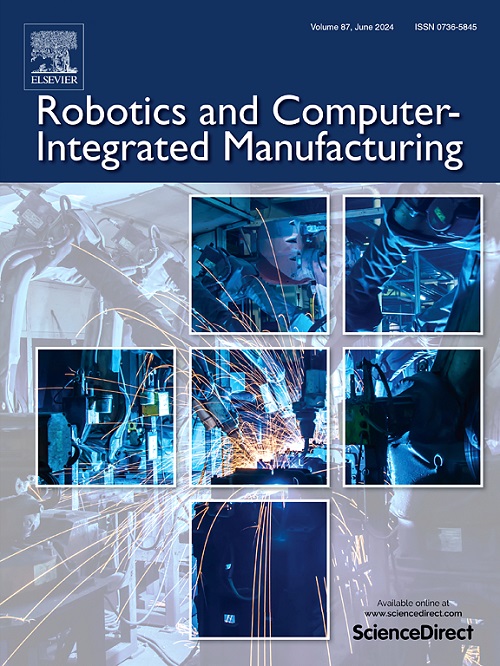制造业中的机器人数字孪生系统:技术、应用、趋势和挑战
IF 11.4
1区 计算机科学
Q1 COMPUTER SCIENCE, INTERDISCIPLINARY APPLICATIONS
引用次数: 0
摘要
在工业4.0框架下,制造业正在经历一场向智能、数字化和柔性生产系统的深刻变革。在这种模式下,数字孪生(DT)作为关键推动者,连接物理和数字领域,以模拟、分析和优化制造运营。同时,通过智能传感器感知、工业物联网连接和自适应控制机制增强的机器人系统,越来越多地用于处理复杂和动态的任务。然而,现代制造业不断变化的需求需要高度的灵活性和响应能力,这就需要更智能的解决方案。机器人数字孪生(RDT)已经成为一种变革性的方法,促进动态适应和持续的运营改进。本文从技术和应用的角度对制造业中RDT的文献进行了全面的审查,旨在为工业4.0的研究人员和从业者提供见解。本文介绍了一种四层RDT系统架构,并总结了工业4.0技术,如工业物联网、云/边缘计算、5g、虚拟现实、建模与仿真、人工智能等如何融合并影响基于该架构的RDT系统。此外,回顾了特定领域和系统级的应用,如装配、加工、抓取、材料处理、人机交互、预测性维护和增材制造系统,并分析了它们的发展现状。最后,从不同层面总结了RDT系统在制造业中的发展趋势、实际挑战和未来的研究方向。本文章由计算机程序翻译,如有差异,请以英文原文为准。
Robot digital twin systems in manufacturing: Technologies, applications, trends and challenges
The manufacturing industry is undergoing a profound transformation toward smart, digital, and flexible production systems under the Industry 4.0 framework. Within this paradigm, Digital Twin (DT) serves as a key enabler, bridging physical and digital domains to simulate, analyse, and optimise manufacturing operations. Concurrently, robotic systems, enhanced by smart sensor perception, Industrial Internet of Things connectivity, and adaptive control mechanisms, are increasingly deployed to handle complex and dynamic tasks. However, the evolving demands of the modern manufacturing industry require a high degree of flexibility and responsiveness, necessitating more intelligent solutions. The Robot Digital Twin (RDT) has emerged as a transformative approach, facilitating dynamic adaptation and continuous operational improvement. This review offers a comprehensive examination of the literature on RDT in manufacturing from both technology and application perspectives, aiming to provide insight for researchers and practitioners in Industry 4.0. The paper introduces a four-layer RDT system architecture and summarises how Industry 4.0 technologies, e.g., the Industrial Internet of Things, Cloud/Edge Computing, 5 G, Virtual Reality, Modelling and Simulation, and Artificial Intelligence, converge and influence the RDT system based on this architecture. Furthermore, the review covers domain-specific and system-level applications, such as assembly, machining, grasping, material handling, human-robot interaction, predictive maintenance, and additive manufacturing systems, with an analysis of their development status. Finally, the trends, practical challenges, and future research directions for RDT systems in manufacturing are summarised at different levels.
求助全文
通过发布文献求助,成功后即可免费获取论文全文。
去求助
来源期刊
CiteScore
24.10
自引率
13.50%
发文量
160
审稿时长
50 days
期刊介绍:
The journal, Robotics and Computer-Integrated Manufacturing, focuses on sharing research applications that contribute to the development of new or enhanced robotics, manufacturing technologies, and innovative manufacturing strategies that are relevant to industry. Papers that combine theory and experimental validation are preferred, while review papers on current robotics and manufacturing issues are also considered. However, papers on traditional machining processes, modeling and simulation, supply chain management, and resource optimization are generally not within the scope of the journal, as there are more appropriate journals for these topics. Similarly, papers that are overly theoretical or mathematical will be directed to other suitable journals. The journal welcomes original papers in areas such as industrial robotics, human-robot collaboration in manufacturing, cloud-based manufacturing, cyber-physical production systems, big data analytics in manufacturing, smart mechatronics, machine learning, adaptive and sustainable manufacturing, and other fields involving unique manufacturing technologies.

 求助内容:
求助内容: 应助结果提醒方式:
应助结果提醒方式:


